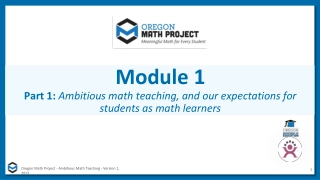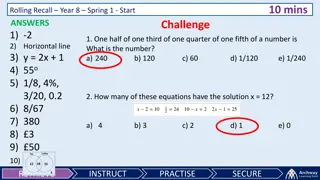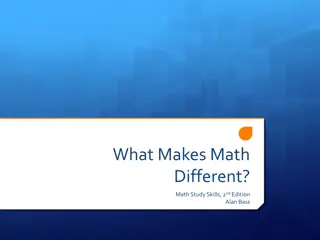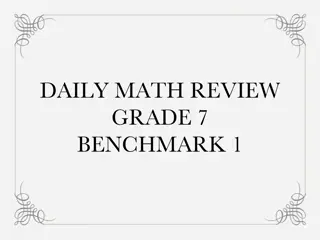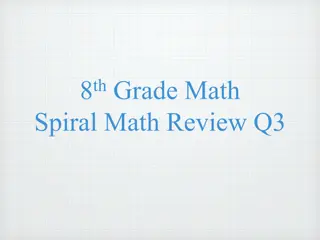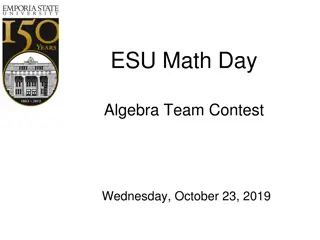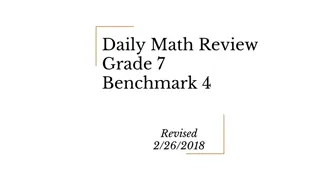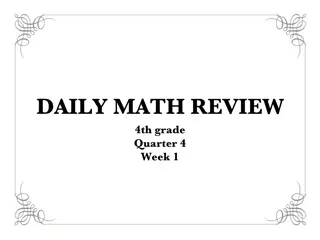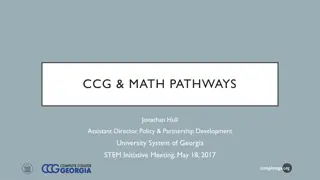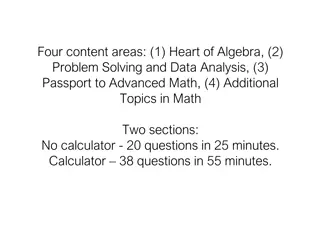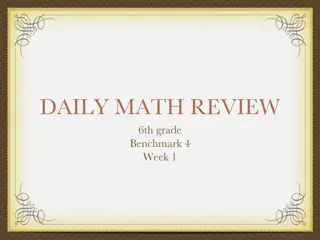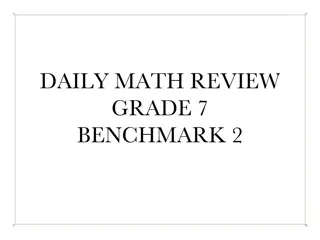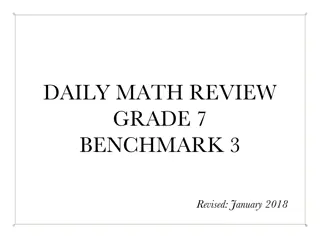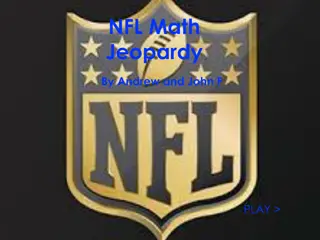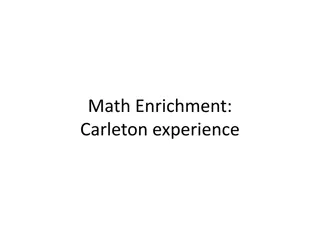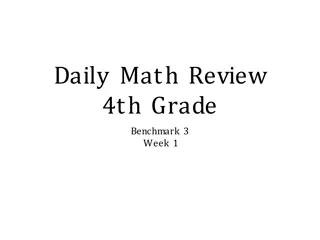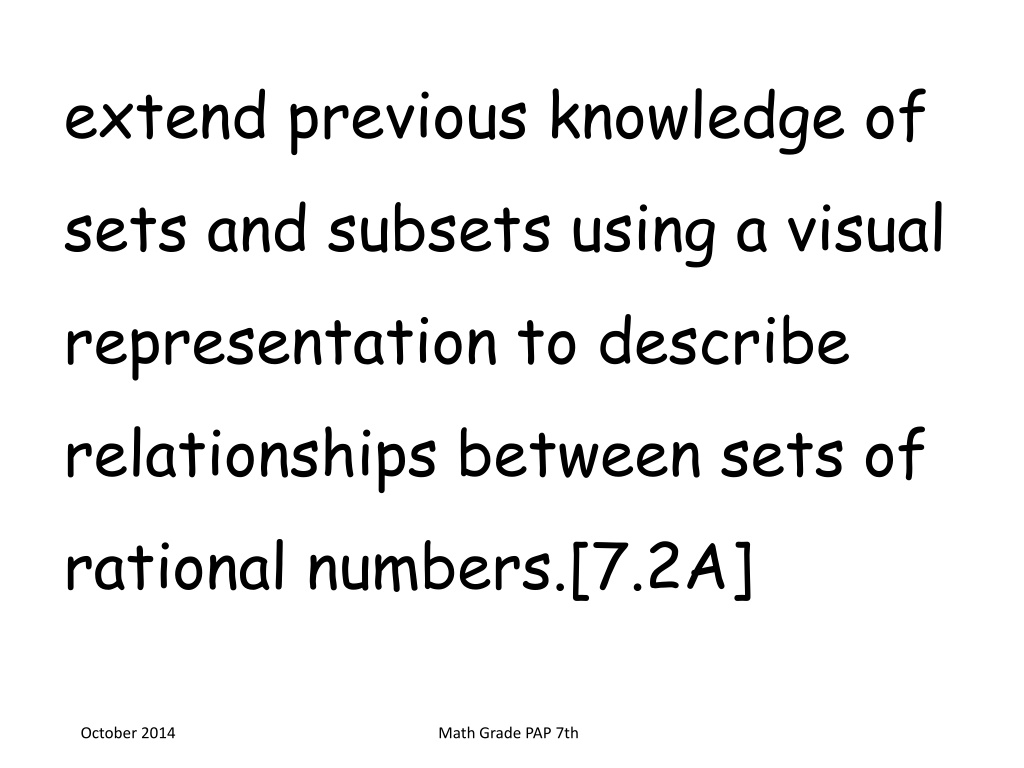
Visual Representation of Relationships Between Sets of Rational Numbers
Enhance your understanding of sets and subsets of rational numbers through visual representations. Explore the connections between sets, apply operations fluently, solve problems using addition, subtraction, multiplication, and division of rational numbers, and more. Dive into constant rates of change, unit rates, proportionality, ratios, percentages, and measurement system conversions. Generalize critical attributes of similarity and ratios within similar shapes for a comprehensive math learning experience.
Download Presentation

Please find below an Image/Link to download the presentation.
The content on the website is provided AS IS for your information and personal use only. It may not be sold, licensed, or shared on other websites without obtaining consent from the author. Download presentation by click this link. If you encounter any issues during the download, it is possible that the publisher has removed the file from their server.
E N D
Presentation Transcript
extend previous knowledge of sets and subsets using a visual representation to describe relationships between sets of rational numbers.[7.2A] October 2014 Math Grade PAP 7th
add, subtract, multiply, and divide rational numbers fluently.[7.3A] October 2014 Math Grade PAP 7th
apply and extend previous understandings of operations to solve problems using addition, subtraction, multiplication, and division of rational numbers.[7.3B] October 2014 Math Grade PAP 7th
represent constant rates of change in mathematical and real-world problems given pictorial, tabular, verbal, numeric, graphical, and algebraic representations, including d = rt.[7.4A] October 2014 Math Grade PAP 7th
calculate unit rates from rates in mathematical and real-world problems.[7.4B] October 2014 Math Grade PAP 7th
determine the constant of proportionality (k = y / x) within mathematical and real-world problems.[7.4C] October 2014 Math Grade PAP 7th
solve problems involving ratios, rates, and percents, including multi-step problems involving percent increase and percent decrease, and financial literacy problems.[7.4D] October 2014 Math Grade PAP 7th
convert between measurement systems, including the use of proportions and the use of unit rates.[7.4E] October 2014 Math Grade PAP 7th
generalize the critical attributes of similarity, including ratios within and between similar shapes.[7.5A] October 2014 Math Grade PAP 7th
describe as the ratio of the circumference of a circle to its diameter.[7.5B] October 2014 Math Grade PAP 7th
solve mathematical and real-world problems involving similar shape and scale drawings.[7.5C] October 2014 Math Grade PAP 7th
represent sample spaces for simple and compound events using lists and tree diagrams. [7.6A] October 2014 Math Grade PAP 7th
select and use different simulations to represent simple and compound events with and without technology. [7.6B] October 2014 Math Grade PAP 7th
make predictions and determine solutions using experimental data for simple and compound events.[7.6C] October 2014 Math Grade PAP 7th
make predictions and determine solutions using theoretical probability for simple and compound events. [7.6D] October 2014 Math Grade PAP 7th
find the probabilities of a simple event and its complement and describe the relationship between the two. [7.6E] October 2014 Math Grade PAP 7th
use data from a random sample to make inferences about a population. [7.6F] October 2014 Math Grade PAP 7th
use data from a random sample to make inferences about a population.[7.6F] October 2014 Math Grade PAP 7th
solve problems using data represented in bar graphs, dot plots, and circle graphs, including part-to-whole and part-to-part comparisons and equivalents.[7.6G] October 2014 Math Grade PAP 7th
solve problems using qualitative and quantitative predictions and comparisons from simple experiments. [7.6H] October 2014 Math Grade PAP 7th
determine experimental and theoretical probabilities related to simple and compound events using data and sample spaces.[7.6I] October 2014 Math Grade PAP 7th
represent linear relationships using verbal descriptions, tables, graphs, and equations that simplify to the form y = mx + b.[7.7A] October 2014 Math Grade PAP 7th
model the relationship between the volume of a rectangular prism and a rectangular pyramid having both congruent bases and heights and connect that relationship to the formulas.[7.8A] October 2014 Math Grade PAP 7th
explain verbally and symbolically the relationship between the volume of a triangular prism and a triangular pyramid having both congruent bases and heights and connect that relationship to the formulas.[7.8B] October 2014 Math Grade PAP 7th
use models to determine the approximate formulas for the circumference and area of a circle and connect the models to the actual formulas.[7.8C] October 2014 Math Grade PAP 7th
solve problems involving the volume of rectangular prisms, triangular prisms, rectangular pyramids, and triangular pyramids.[7.9A] October 2014 Math Grade PAP 7th
determine the circumference and area of circles.[7.9B] October 2014 Math Grade PAP 7th
determine the area of composite figures containing combinations of rectangles, squares, parallelograms, trapezoids, triangles, semicircles, and quarter circles.[7.9C] October 2014 Math Grade PAP 7th
solve problems involving the lateral and total surface area of a rectangular prism, rectangular pyramid, triangular prism, and triangular pyramid by determining the area of the shape's net.[7.9D] October 2014 Math Grade PAP 7th
write one-variable, two-step equations and inequalities to represent constraints or conditions within problems. [7.10A] October 2014 Math Grade PAP 7th
represent solutions for one- variable, two-step equations and inequalities on number lines.[7.10B] October 2014 Math Grade PAP 7th
write a corresponding real-world problem given a one-variable, two-step equation or inequality.[7.10C] October 2014 Math Grade PAP 7th
model and solve one-variable, two-step equations and inequalities.[7.11A] October 2014 Math Grade PAP 7th
determine if the given value(s) make(s) one-variable, two-step equations and inequalities true.[7.11B] October 2014 Math Grade PAP 7th
write and solve equations using geometry concepts, including the sum of the angles in a triangle, and angle relationships.[7.11C] October 2014 Math Grade PAP 7th
compare two groups of numeric data using comparative dot plots or box plots by comparing their shapes, centers, and spreads. [7.12A] October 2014 Math Grade PAP 7th
use data from a random sample to make inferences about a population.[7.12B] October 2014 Math Grade PAP 7th
compare two populations based on data in random samples from these populations, including informal comparative inferences about differences between the two populations.[7.12C] October 2014 Math Grade PAP 7th
calculate the sales tax for a given purchase and calculate income tax for earned wages. [7.13A] October 2014 Math Grade PAP 7th
identify the components of a personal budget, including income; planned savings for college, retirement, and emergencies; taxes; and fixed and variable expenses, and calculate what percentage each category comprises of the total budget.[7.13B] October 2014 Math Grade PAP 7th
create and organize a financial assets and liabilities record and construct a net worth statement.[7.13C] October 2014 Math Grade PAP 7th
use a family budget estimator to determine the minimum household budget and average hourly wage needed for a family to meet its basic needs in the student's city or another large city nearby.[7.13D] October 2014 Math Grade PAP 7th
calculate and compare simple interest and compound interest earnings.[7.13E] October 2014 Math Grade PAP 7th
analyze and compare monetary incentives, including sales, rebates, and coupons.[7.13F] October 2014 Math Grade PAP 7th
extend previous knowledge of sets and subsets using a visual representation to describe relationships between sets of real numbers.[8.2A] October 2014 Math 8th Grade
approximate the value of an irrational number, including and square roots of numbers less than 225, and locate that rational number approximation on a number line.[8.2B] October 2014 Math 8th Grade
convert between standard decimal notation and scientific notation.[8.2C] October 2014 Math 8th Grade
order a set of real numbers arising from mathematical and real-world contexts.[8.2D] October 2014 Math 8th Grade
generalize that the ratio of corresponding sides of similar shapes are proportional, including a shape and its dilation.[8.3A] October 2014 Math 8th Grade
compare and contrast the attributes of a shape and its dilation(s) on a coordinate plane.[8.3B] October 2014 Math 8th Grade

